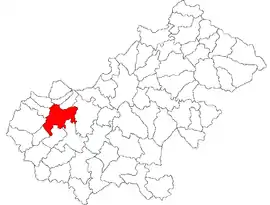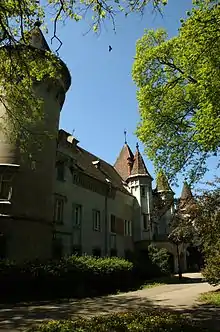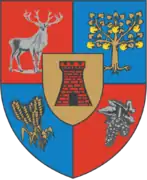Carei
Carei (Romanian pronunciation: [kaˈrej]; Hungarian: Nagykároly, Hungarian pronunciation: [ˈnɒckaːroj]; German: Grosskarol/Großkarl, Yiddish: קראלי, Yiddish pronunciation: [Krʊlə]; Turkish: Karolvar) is a city in Satu Mare County, northwestern Romania, near the border with Hungary.
Carei
Nagykároly | |
|---|---|
 The Károlyi castle in Carei | |
 Flag  Coat of arms | |
 Location in Satu Mare County | |
 Carei Location in Romania | |
| Coordinates: 47°41′2″N 22°28′1″E | |
| Country | |
| County | Satu Mare |
| Established | 1264 Incorporated: 1717 |
| Government | |
| • Mayor | Jenő Kovács[1] (UDMR) |
| Area | 102 km2 (39 sq mi) |
| Population (2011)[2] | 21,112 |
| • Density | 210/km2 (540/sq mi) |
| Time zone | EET/EEST (UTC+2/+3) |
| Vehicle reg. | SM |
| Website | www |
Name
The city was named after an old noble family, the Károlyi. Carei administers one village, Ianculești (Hungarian: Szentjánosmajor).
History

In 1262, in a document, Karul appears as a name of a person, but the etymology of the word can be traced back to the name of a bird karul-karvaly, taken from the ancient Turkish language. Karul may be derived from "car" in Romanian. The bird that can be found on the coat of arms of the Karolyi family.
King Louis I of Hungary permitted the organization of weekly market gatherings in Carei in 1346, as a result of the military achievements of the Károlyi family.[3] The development of regional trade in the region stimulated the development of the town.
In the 14th century, the settlement was a small township with a few streets built around the Károlyi estate. Wars, plague and famine during the Middle Ages decimated the population and the Károlyi family took steps to bring Swabian settlers to their lands. During the 16th and 17th centuries, Carei was often devastated by wars. The town and the surroundings villages suffered great losses during Rákóczi's War of Independence.
The first group of settlers came in 1712, opening a century-long period of gradual colonization with Swabians, Slovaks, and Jews. Between 1712 and 1774, some 466 Swabian families settled in Carei, forming two districts in town. Effects on cultural and social life began to show: in 1727 the Piarist Gymnasium was established, in 1754 the first typography was built, and in 1756 a pharmacy was opened.
The town's urban shape was outlined after the great fire that occurred in May 1887, when 250 houses were burnt down. The rebuilding of the houses and the organizing of the streets were done according to the planning regulations adopted by the town's council.
Light industry began to bloom in Carei starting with the 19th century, when the first public institutions were also created. In 1887 the Zalău–Carei railway was built and in 1905 the railway between Carei and Mátészalka was restored for transportation purposes.
After the collapse of Austria-Hungary at the end of World War I, and the declaration of the Union of Transylvania with Romania, the Romanian Army took control of Carei on April 19, 1919, during the Hungarian–Romanian War. The city officially became part of the territory ceded to the Kingdom of Romania in June 1920 under the terms of the Treaty of Trianon. In August 1940, under the auspices of Nazi Germany, which imposed the Second Vienna Award, Hungary retook the territory of Northern Transylvania (which included Carei) from Romania. Towards the end of World War II, however, the city was taken back from Hungarian and German troops by Romanian and Soviet forces on 25 October 1944, during the Battle of Carei. In memory of this battle, the "Monument of the Romanian Soldier" was erected in the center of Carei; inaugurated in 1964, it is the work of the sculptor Gheza Vida. The 25th of October has been celebrated since 1959 as the Day of the Romanian Armed Forces.
Although between 1760 and 1920 the town was the seat of the Szatmár County, the industrial development was not significant and it basically preserved its agricultural specificity until about 1960. In 1926 Carei was attached to Sălaj County. After 1950, Carei was included in the Baia Mare Region, while after 1968, along with the administrative-territorial reorganization of the country, it returned to Satu Mare County.
Until World War II, the industry of the town consisted of mills, the Oil Factory Ardealul, a station for collecting and fermenting tobacco and some small workshops. During the Communist period, Carei gradually turned into an industrial town.
Tourism
The most important historical building in the city is the Károlyi castle. Built originally as a fortress around the 14th century, it was converted to a castle in 1794, undergoing further transformations during the 19th century. The manor is surrounded by an arboretum, covering a surface of about 30 acres (12 ha) and containing a great variety of species of trees and plants.
Demographics
| Year | Pop. | ±% |
|---|---|---|
| 1880 | 12,523 | — |
| 1890 | 13,475 | +7.6% |
| 1900 | 15,382 | +14.2% |
| 1910 | 16,078 | +4.5% |
| 1920 | 15,294 | −4.9% |
| 1930 | 16,042 | +4.9% |
| 1941 | 15,850 | −1.2% |
| 1956 | 16,780 | +5.9% |
| 1966 | 19,686 | +17.3% |
| 1977 | 24,050 | +22.2% |
| 1992 | 26,372 | +9.7% |
| 2002 | 22,781 | −13.6% |
| 2011 | 20,775 | −8.8% |
| Source: Census data[4] | ||
According to the 2011 census, Carei had a population of 21,112; out of those, 51.9% were Hungarian, 38.3% were Romanian, 2.3% were German, and 2.2% were Roma.[5] As to religion, 36% of the commune population were Roman Catholic, 32% of them were Romanian Orthodox and 20% were Reformed (Calvinist).[6]
Notable residents


Politics
- Sándor Károlyi de Nagykároly (1668–1743), Hungarian aristocrat, statesman and Imperial Feldmarschall
- Salvator Cupcea (1908–1958), Romanian psychologist, physician, and political figure
- Oszkár Jászi (1875–1957), Hungarian Jewish social scientist, historian, and politician
Religion
- Gáspár Károli (1529–1591), Hungarian Calvinist pastor, translator (first translation of the Bible to Hungarian in 1586)
- Jenő Schönberger (1959–), Hungarian cleric, bishop of the Roman Catholic Diocese of Satu Mare
- Vasile Hossu (1919 – 1997), Romanian Greek Catholic hierarch
- Alexander Ratiu (1916–2002), Romanian-American priest of the Romanian Greek-Catholic Church
- Yosef Leifer (1891–1966), founder and first Rebbe of the Pittsburg Hasidic dynasty
- Avraham Abba Leifer (1918–1990), second Rebbe of the Pittsburg Hasidic dynasty
- Joel Teitelbaum (1887–1979), founder and first Grand Rebbe of the Satmar dynasty
Sports
- Miklós Bródy (1877–1949), Hungarian-Romanian chess master
- Eric Bicfalvi (1988–), Hungarian-Romanian footballer
- Adrian Sălăgeanu (1983–), Romanian footballer
- Dionisiu Bumb (1973–), Romanian footballer
- Szabolcs Perényi (1982–), Romanian-born Hungarian footballer
- Silviu Lung (1956–), Romanian footballer
- Florin Fabian (1974–), Romanian footballer
- Cornel Pavlovici (1942–2013), Romanian footballer
- István Kovács (1984 –), Romanian football referee
- Iosif Budahazi (1947–),Romanian fencer
- Tünde Vaszi (1972–), Romanian long jumper
Others
- Margit Kaffka (1880–1918), Hungarian female writer and poet
- Antal Ligeti (1823–1890), Hungarian landscape painter
- Ferdinánd Barna (1825–1895), Hungarian linguist, translator and librarian of the Hungarian Academy of Sciences
International relations
Climate
Carei has a continental climate, characterized by hot dry summers and cold winters. As the city is in the far north of the country, winter is colder than the national average. The average annual temperature is 9.6 °C (49 °F).[9]
| Climate data for Satu Mare | |||||||||||||
|---|---|---|---|---|---|---|---|---|---|---|---|---|---|
| Month | Jan | Feb | Mar | Apr | May | Jun | Jul | Aug | Sep | Oct | Nov | Dec | Year |
| Average high °C (°F) | 0 (32) |
3 (37) |
10 (50) |
15 (59) |
20 (68) |
22 (72) |
25 (77) |
25 (77) |
21 (70) |
15 (59) |
7 (45) |
2 (36) |
13 (55) |
| Daily mean °C (°F) | −2 (28) |
0 (32) |
5 (41) |
10 (50) |
15 (59) |
17 (63) |
19 (66) |
19 (66) |
16 (61) |
10 (50) |
3 (37) |
0 (32) |
9 (48) |
| Average low °C (°F) | −5 (23) |
−3 (27) |
1 (34) |
5 (41) |
9 (48) |
12 (54) |
13 (55) |
13 (55) |
10 (50) |
5 (41) |
0 (32) |
−2 (28) |
5 (41) |
| Average precipitation cm (inches) | 2 (0.8) |
2 (0.8) |
2 (0.8) |
4 (1.6) |
7 (2.8) |
8 (3.1) |
8 (3.1) |
7 (2.8) |
4 (1.6) |
4 (1.6) |
3 (1.2) |
2 (0.8) |
59 (23) |
| Source: weatherbase.com[10] | |||||||||||||
Gallery
 Saint Joseph Calasanctius Church
Saint Joseph Calasanctius Church The Calvinist church
The Calvinist church The synagogue
The synagogue The town hall
The town hall The Romanian Soldiers' Monument
The Romanian Soldiers' Monument The Károlyi castle
The Károlyi castle The Károlyi castle
The Károlyi castle The Károlyi castle
The Károlyi castle The castle's water tower
The castle's water tower Coat of Arms on the wall of the Károlyi castle
Coat of Arms on the wall of the Károlyi castle
References
- "Results of the 2016 local elections". Central Electoral Bureau. Retrieved 3 April 2020.
- "Populaţia stabilă pe judeţe, municipii, oraşe şi localităti componenete la RPL_2011" (in Romanian). National Institute of Statistics. Retrieved 4 February 2014.
- Ujfalussy Amadil: Nagykároly
- Census Database
- Tab8. Populația stabilă după etnie – județe, municipii, oraşe, comune, 2011 census results, National Institute of Statistics, accessed 9 March 2020.
- Tab13. Populația stabilă după religie – județe, municipii, orașe, comune, 2011 census results, National Institute of Statistics, accessed 9 March 2020.
- "Partnerstwo Samorządów Siłą Europy". Europa Miast (in Polish). Archived from the original on 9 August 2016. Retrieved 13 August 2013.
- "Dębica -Miasta Partnerskie" [Dębica – Partnership Cities]. Rząd Miejski w Dębicy – Współpraca – Europa Miast [Dębica town council in cooperation with Europa Miast] (in Polish). Archived from the original on 11 October 2011. Retrieved 13 August 2013.
- "Geografie" (in Romanian). www.satu-mare.ro. Archived from the original on 12 June 2009. Retrieved 22 June 2009.
- "Weatherbase data for Satu Mare". Retrieved 22 June 2009.
External links
| Wikimedia Commons has media related to Carei. |
- Official site of Carei (in Romanian)
- Nagykárolyi Napló (in Hungarian)
